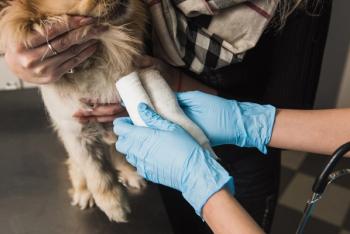
Critical care analgesia: Abdominal pain (Proceedings)
"Acute abdomen" is widely understood by clinicians as a potentially serious syndrome that is typically accompanied by spontaneous and evoked behavioral signs of pain.
"Acute abdomen" is widely understood by clinicians as a potentially serious syndrome that is typically accompanied by spontaneous and evoked behavioral signs of pain. Although the incidence of clinically significant abdominal pain in companion animals presented for veterinary care is unknown, it is associated a long list of disorders (Table 1). Abdominal pain is a common reason to seek medical care in humans, accounting for > 7.5 million (6.8% of total) emergency room presentations annually in the US alone [
Table 1: Sources of abdominal pain
Sources of abdominal pain
Common stimuli for pain include ischemia, inflammation, increased wall tension from distention of the GI tract, biliary system, or urinary bladder, and capsular distention of solid organs. The abdominal cavity is served by nociceptors located in both the parietal and visceral peritoneum. Visceral nociceptive afferents are relatively few in number and diverge over several nerve roots; thus the same dorsal nerve root may contain afferents from several abdominal locations offering only vague neuroanatomic localization. Signal transmission via the medial ascending nociceptive system probably contributes to the sense of dull, aching, poorly localized pain in humans.
Somatic afferents are located in the peritoneum, root of the mesentery, and abdominal wall. These afferents tend to enter discrete cord segments, decussate, ascend via the lateral spinal tracts, enter the thalamus and project to the somatosensory cortex. Compared with visceral nociception, the pain from stimulation of the somatic sensory system in humans yields pain that is sharper in nature and more readily localized to specific dermatomes.
Diagnosis
History: Abdominal pain in dogs and cats is typically recognized as acute, but may be recurrent over time. Although chronic pain syndromes surely occur in dogs and cats, its existence is often suspected based on rather vague and subtle behavioral changes that are difficult to assess. Veterinary counterparts to the causes of human chronic abdominal pain syndromes (for example, abdominal adhesions) do exist1, but the reports of pain so consistently described in humans are absent or minimized in the case reports in veterinary literature. To the author's knowledge there are no veterinary reports detailing assessment of abdominal pain in dogs and cats beyond empiric observations within a case series, and the primary focus of those reports was not abdominal pain. Tellingly, a close read of reports of success in treating chronic conditions often include post-treatment observations of improved activity and appetite that suggest pain was a major feature of the syndrome, even when the owner and veterinarian had not appreciated it. In the author's experience, owner histories are often limited to observation of partial or complete anorexia, changes in interactions (soliciting attention or becoming reclusive), and gastrointestinal signs (vomiting, diarrhea). Occasionally, owners do report observations regarding restlessness with inability to lie comfortably, facial features of anxiety or distress, guarding of the abdominal wall and or thoracolumbar spine, difficulty rising, a stiff gait when walking, and difficulty posturing to urinate or defecate. A history of foreign body ingestion, access to toxins, or potential for trauma may help direct diagnostic efforts.
Signalment: Patient signalment often affects the differential diagnosis list in companion animals with abdominal pain. Young dogs are commonly affected by foreign body ingestion, viral gastroenteritis, and are more prone to develop intestinal intussusceptions. Deep-chested large and giant breeds are more likely to develop gastric dilatation-volvulus, overweight middle age dogs may be more likely to develop pancreatitis, and middle-age or older cats may develop arterial emboli.
Physical examination may reveal the same behavioral signs observed reported by owners. However, if the pain is not severe the compelling behavioral changes seen at home may vanish in the novel environment of the veterinary clinic. There may be changes suggesting pain originating in the torso, such as a stiff gait, reluctance to be handled, difficulty rising, and guarding of the abdomen or thoracolumbar spine. During palpation, pain localized to the anterior abdomen may suggest pancreatitis, gastric dilatation-volvulus, biliary tract disease, acute liver swelling, or intestinal ischemia/distention. Caudal abdominal pain may be more consistent with urogenital disease (cystitis, prostatitis, metritis). Generalized pain may indicate peritonitis, gastroenteritis, uremia, hypoadrenocorticism, or gastric or intestinal volvulus. Diseases associated with a systemic inflammatory response may produce other findings including fever or hypothermia, injected mucus membranes, cardiovascular features of sepsis, and others. Physical signs of abdominal pain may accompany other abnormalities on physical examination. The clinician should evaluate the patient's level of consciousness and ability to engage with its environment, vital signs, and cardiopulmonary signs. Oral (for string foreign body under the tongue) and rectal (including evaluation of the feces) examinations may provide useful information. Visual inspection of the torso may reveal evidence of trauma, herniation, or infection of the abdominal wall. The abdomen should be inspected for distention, asymmetry, presence of fluid or gas, hepato/spleno/renomegaly, gastric, intestinal, or bladder distension, intestinal mass, enlargement of the prostate or uterus. The abdomen may be too tense to palpate deeply; in some cases resting your hand on the abdomen for 10-30 seconds before palpation may allow the patient to relax enough to allow light palpation.
Diagnostic testing
The history and physical examination should narrow the differential list somewhat. Identification of physical abnormalities is often an indication for imaging studies, particularly if metabolic disorders are absent. Imaging modalities include plain and contrast radiographs, and abdominal ultrasound. Occasionally, more complex (and usually chronic) conditions may require CT or MRI imaging to assist with surgical plans. The presence of abdominal effusion should prompt immediate diagnostic abdominocentesis (with or without ultrasound guidance) and fluid analysis. Regardless of your cytology skills, don't waste this opportunity to screen for septic peritonitis (suppurative inflammation with intracellular bacteria) or intra-abdominal hemorrhage (blood that does not clot)! Septic peritonitis is an indication to skip any planned imaging studies and proceed directly to rapid, aggressive stabilization and, if successfully stabilized, surgical exploration (animals that cannot be stabilized usually require euthanasia rather than surgery). Hemoabdomen warns you against excessive manipulation (palpation, restraint for radiographs, careless lifting of the patient), prompts you to carefully monitor the cardiovascular system for signs of progression to hemorrhagic shock, to be conservative regarding fluid therapy (small volumes, avoid hetastarch), and to plan on early surgical exploration (when the clinical course is rapid and progressive). Neither of these syndromes requires much skill at cytology!
Laboratory tests to consider include CBC, chemistry profile, and urinalysis. Although by themselves nonspecific, when combined with history and physical findings these screening tests often help support or confirm the clinical diagnosis.
Therapy pointers
Severe acute pain often has an underlying cause that requires immediate correction. Sometimes treatment of the underlying condition rapidly alleviates pain, for example gastric decompression in dogs with GDV. When this is not possible or does not alleviate pain, some analgesic drug therapies to consider include opioids, ketamine, local/regional anesthesia, nonsteroidal anti-inflammatory drugs, and topical therapy:
Opioids remain a key component of therapy for abdominal pain. Both the analgesia and side effects are dose-dependent, so the amount administered can be titrated to provide at least some analgesia while avoiding unwanted side effects. It is an unusual patient that cannot tolerate at least a low dose of opioid, and even when that dose is insufficient to provide analgesia it may reduce the dosage requirements for other drugs. Although opioids may aggravate vomiting and ileus, use of low doses and slow administration rates often limit these side effects. Some animals with abdominal pain and vomiting actually have less vomiting following opioid therapy, suggesting that pain was a primary stimulus for the vomiting and on balance the opioid effect was beneficial. Systemic opioids increase the pressure within the common bile duct of healthy dogs; although this could worsen abdominal pain in some animals with pancreatitis, on balance it may relieve pain and this therapy is not necessarily contraindicated in dogs with biliary or pancreatic disease. In the critically ill animal with gastroparesis, sedation with opioids or other drugs may predispose them to aspiration injury. Close monitoring and maintaining gastric decompression (with a nasogastric tube or gastrotomy tube) are warranted.
Local anesthetics may be administered epidurally or intraperitoneally. Although epidural analgesia with a combination of opioid and bupivacaine (.0625 – .25%) can provide profound pain relief, this approach must be used in caution in patients with a significant systemic inflammatory response.5 We have successfully used intraperitoneal catheters to treat the pain from pancreatitis and bile peritonitis by either continuous infusion of lidocaine 3 mg/kg/hour (dogs only) or intermittent injection of bupivacaine 0.25% (1 mg/kg q 6 hours in dogs, 0.5 mg/kg q 6 hours in cats).
Nonsteroidal anti-inflammatory drugs may be administered as soon as hemodynamic stability is achieved and if there is no evidence of significant active hemorrhage or acute renal injury. Because COX-2 selective drugs inhibit intestinal healing, it may be prudent to avoid them in animals with intestinal tract incisions – particularly in light of the observation that a significant fraction of dogs with intestinal incisions develop postoperative wound dehiscence.
References
Weber NA: Chronic primary splenic torsion with peritoneal adhesions in a dog: case report and literature review. J Am Anim Hosp Assoc 36(5):390-394, 2000.
Hardie EM, Rottman JB, Levy JK: Sclerosing encapsulating peritonitis in four dogs and a cat. Vet Surg 23(2):107-114, 1994.
Applewhite AA, Hawthorne JC, Cornell KK: Complications of enteroplication for the prevention of intussusception recurrence in dogs: 35 cases (1989-1999). J Am Vet Med Assoc 219(10):1415-1418, 2001.
Vatashsky E, Haskel Y, Beilin B, et al: Common bile duct pressure in dogs after opiate injection— epidural versus intravenous route. Canadian Anaesthetists Society Journal 31):650-653, 1984.
Solomon SB, Banks SM, Gerstenberger E, et al: Sympathetic blockade in a canine model of gram-negative bacterial peritonitis. Shock 19(3):215-222, 2003.
de Hingh I, van Goor H, de Man BM, et al: Selective cyclo-oxygenase 2 inhibition affects ileal but not colonic anastomotic healing in the early postoperative period. Br J Surg 93(4):489-497, 2006.
Ralphs SC, Jessen CR, Lipowitz AJ: Risk factors for leakage following intestinal anastomosis in dogs and cats: 115 cases (1991-2000). J Am Vet Med Assoc 223(1):73-77, 2003
Newsletter
From exam room tips to practice management insights, get trusted veterinary news delivered straight to your inbox—subscribe to dvm360.




